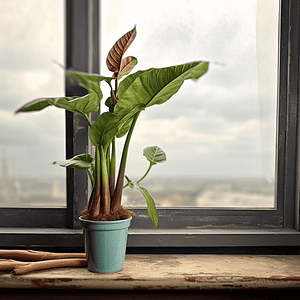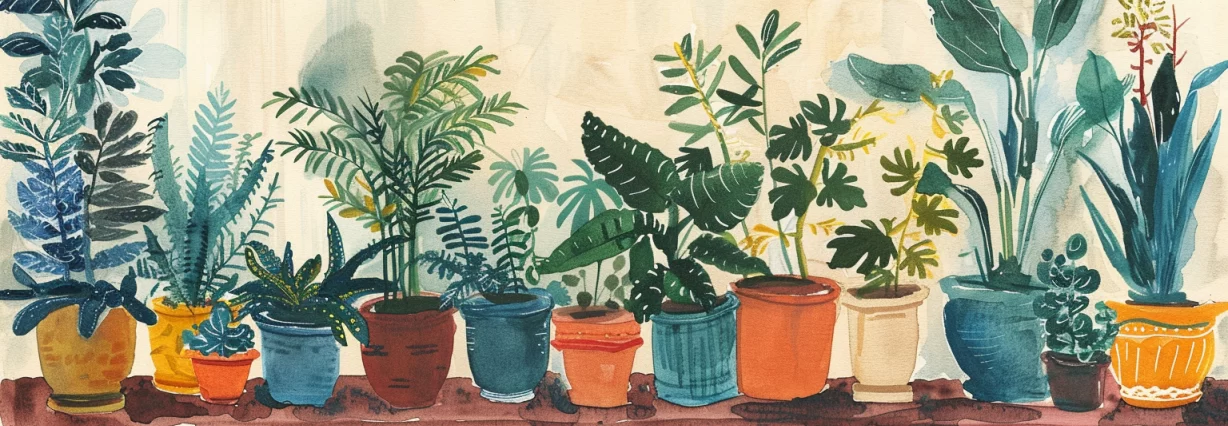Philodendron Subhastatum is a stunning tropical climbing plant known for its bicolored leaves and low maintenance requirements. This captivating species from the Araceae family is not only a great indoor decorative element, but also an easy-to-grow addition that can truly uplift your space. Because of its love for water and ability to thrive even when placed in indirect or low light, Philodendron Subhastatum stands out compared to other philodendrons species.
Caring for this plant is simple, with straightforward light, water, and nutritional needs. When it comes to propagation, the subhastatum stands out for its adaptability, making it an excellent option for both seasoned plant lovers and beginners. As with all philodendrons, ensuring that you provide proper potting and support is crucial, as these plants are natural climbers. Familiarizing yourself with the potential common problems and their solutions when it comes to this species will help you keep your plant thriving and looking its best.
Key Takeaways
- Philodendron Subhastatum is a tropical climber with distinct bicolor leaves.
- Simple care requirements and easy propagation make it ideal for both experienced and novice plant enthusiasts.
- To maintain its health and beauty, it’s important to provide proper potting and support, as well as familiarize oneself with potential common problems and their solutions.
Care and Growth
Watering and Soil
Philodendron Subhastatum requires a balance of abundant water and well-draining soil to thrive. Water the plant regularly, but allow the soil to dry out between watering to prevent root rot. A good potting mix to use is a combination of well-draining soil and added perlite. This mixture ensures proper drainage and prevents the plant from sitting in waterlogged soil.
Light and Temperature
These plants prefer bright, indirect sunlight due to their origins in tropical forests as understory plants near riverbanks. Too much direct sunlight may cause leaf burn. Ideally, place the plant in a location with filtered light or partial shade, as this will help it grow healthily.
The optimal temperature range for Philodendron Subhastatum is between 65-75°F (18-24°C). It is crucial to maintain this temperature range and protect the plant from sudden temperature fluctuations.
Humidity and Fertilizing
As a tropical plant, Philodendron Subhastatum enjoys high humidity. Aim for around 60% humidity to keep the plant happy. To create a humid environment, mist the plant regularly, use a humidifier, or place the plant on a tray filled with water and pebbles.
Fertilizing is an essential aspect of the plant’s care. During the growing season (spring and summer), feed the plant once a month with a balanced liquid fertilizer. This will promote healthy growth and address the plant’s nutritional needs.
In summary, provide Philodendron Subhastatum with adequate water, well-draining soil, bright, indirect light, and a stable temperature while maintaining high humidity and regular fertilization to ensure its optimal growth and health.
Propagation and Repotting
Methods
There are two primary methods to propagate a Philodendron Subhastatum: stem cuttings and air layering. Stem cuttings involve trimming a healthy stem from the parent plant, dipping it in rooting hormone, and planting it in a suitable medium. This method allows for relatively quick growth and is the most common.
Air layering is another technique for Philodendron Subhastatum propagation that involves making a small cut or notch in a healthy stem, wrapping the wounded area with moist sphagnum moss, and securing it with plastic wrap. Over time, roots will form at the wounded site, and once the roots are established, the cutting can be removed and planted in its own pot. This method is less invasive and can result in a more established plant quicker than stem cutting.
Timing
The optimal time for propagating and repotting a Philodendron Subhastatum is during the spring or summer. The plant is actively growing during these seasons, ensuring that new growth will develop well. This is also the best time to prune your Philodendron if it becomes leggy or has unruly growth. When repotting, examine for roots poking out from the bottom of the pot, as this is an indication that the plant has become root bound and requires a larger pot ^3^.
It is important to keep in mind that Philodendron Subhastatum is a water-loving plant when taking care of the newly propagated and repotted plant. Ensuring that the top 2 inches of the soil is dry before watering will help maintain the proper moisture level^4^.
Potting and Support
Pot and Soil Mix
When potting your Philodendron Subhastatum, opt for a well-draining soil mix that allows excess water to escape easily to prevent root rot. A reliable mix may contain equal parts of potting soil, perlite, and orchid bark chips. Adding a bit of sand can further enhance the soil’s drainage capacity. Choose a container with drainage holes, as the plant shouldn’t sit in waterlogged soil.
For moisture retention, consider using a pebble tray underneath the pot. Simply fill a shallow tray with water and pebbles, then place the pot on top of it. As the water evaporates, it increases humidity around the plant, which the Philodendron Subhastatum enjoys.
Support and Climbing
The Philodendron Subhastatum is a tropical climber, so it’s essential to provide proper support for its growth. To create a suitable environment for a healthy stem, use a climbing structure, such as a moss pole or a coconut coir pole. Attach the plant’s aerial roots to the support using plant ties or clips to ensure it remains securely anchored.
Allow your Philodendron Subhastatum to climb upwards, mimicking its natural growth habit in tropical wet and pluvial forests. Providing this support not only helps create a visually appealing display but also promotes its overall health and vigor.
It is necessary to monitor the plant regularly, as it may need occasional pruning to maintain a manageable size and shape. This careful attention will help your Philodendron Subhastatum thrive and exhibit its unique, eye-catching foliage.
Common Problems and Solutions
Pests
Philodendron Subhastatum may occasionally be bothered by pests such as mealybugs, scales, and aphids. You can use neem oil or horticultural oil to treat these pests. Regularly inspect the foliage and keep your plant clean to prevent infestations.
Diseases
One common disease that may affect the Philodendron Subhastatum is algal leaf spot. This disease is usually characterized by grayish-green patches on the leaves. To avoid algal leaf spot, maintain proper watering practices and ensure good air circulation around your plant.
Water Issues
Overwatering can be a significant issue for Philodendron Subhastatum, potentially leading to root rot. To avoid these problems, ensure that the top 2 inches of soil are dry before watering your plant. Overwatering can also cause the leaves to turn brown. Always monitor your plant for signs of excess moisture and adjust your watering schedule accordingly.
Light Problems
Philodendron Subhastatum thrives in bright, indirect light. However, if exposed to excessive sunlight, the plant’s foliage may scorch and suffer damage. To avoid this issue, keep your Philodendron Subhastatum 4-6 feet away from the window and ensure that it receives no more than 1-2 hours of morning sunlight daily. Be attentive to any changes in lighting conditions and adjust your plant’s position as necessary.

Purchasing and Pricing
Philodendron Subhastatum plants can be found on various online marketplaces and specialist nurseries, catering to a range of budgets and plant sizes. One popular destination to purchase this plant is Etsy, where prices start from $9.00, with several sellers offering different buying options such as free shipping or discounted rates.
Growers and nurseries specializing in rare and tropical plants may also offer Philodendron Subhastatum, including variegated versions. These establishments may have a limited stock, so it’s essential for potential buyers to keep an eye on their websites and social media channels for announcements.
When purchasing Philodendron Subhastatum, it’s crucial to ensure the plant is healthy, well-established, and comes from a reputable source or nursery in order to guarantee success in your home or greenhouse. Happy growing!
Additional Information
Philodendron Subhastatum, a rare tropical climber belonging to the Araceae family, is admired for its lush, elongated leaves and attractiveness as an ornamental plant. Caring for this plant involves providing appropriate sunlight, watering, and fertilizing to ensure its health and growth.
This plant thrives in moderate, indirect sunlight, ideally within a room that maintains a warm temperature between 59-86°F (15-30°C). Providing consistent room temperature is crucial, as dramatic fluctuations can impact its health. When placing the plant outdoors, it is essential to ensure it is within the appropriate USDA hardiness zones, typically fitting for zones 9 and above.
Watering the Philodendron Subhastatum every 9-10 days is recommended, adjusting the frequency depending on its specific water requirements. Overwatering should be avoided, as it can lead to root rot. A well-draining soil mix is crucial to prevent roots from being submerged in water and to offer the necessary nutrients for growth.
When it comes to fertilizing, a bimonthly application of a balanced fertilizer containing essential nutrients will help maintain the plant’s health. Ensuring adequate humidity, between 60% and 80%, is also crucial for its growth. A simple method to increase humidity involves placing the plant within a closed environment, such as a plastic bag, or by placing it near a humidifier.
Philodendron Subhastatum can be grown both indoors and outdoors, making it a versatile choice for garden enthusiasts. It can reach a height of up to 3-4 feet when placed in a hanging basket, which also allows the plant to showcase its cascading foliage.
In summary, taking into account the Philodendron Subhastatum’s sunlight, water, and nutrient requirements, as well as maintaining a warm room temperature, will help ensure its growth and contribute to its aesthetic appeal as an ornamental plant. With proper care, you can enjoy this beautiful addition to your home or outdoor garden.
Frequently Asked Questions
How do you care for a Philodendron subhastatum?
To care for a Philodendron subhastatum, ensure it receives 4-6 hours of indirect sunlight daily and maintain a temperature of 59-86°F. Water the plant when the top 1-2 inches of soil feel dry, and keep it in well-draining soil. It’s also important to provide support for its climbing habits, such as a moss pole or trellis. Maintain humidity levels above 60% for optimal growth.
What is the common name of Philodendron subhastatum?
Philodendron subhastatum does not have a widely recognized common name.
How much light does a Philodendron subhastatum need?
A Philodendron subhastatum needs at least 4-6 hours of indirect sunlight daily. It is best to expose the plant to morning sunlight for 1-2 hours and keep it 4-6 feet away from windows to prevent scorching from excessive light.
Is the Philodendron subhastatum a rare plant?
Yes, Philodendron subhastatum is considered a rare tropical climber from the Araceae plant family.
What is the difference between Philodendron subhastatum and Hastatum?
Philodendron subhastatum and Hastatum are different species within the Philodendron genus. Both are tropical climbing plants, but their leaf shapes, growth habits, and ideal growing conditions may differ. While subhastatum has elongated leaves, Hastatum features a silvery-blue hue on its leaves, earning it the common name “Silver Sword.”
What is the price range for a Philodendron subhastatum?
The price range for a Philodendron subhastatum varies depending on the size, rarity, and availability of the plant, but it tends to be priced higher than more common Philodendron species due to its rarity. Expect to pay anywhere from $30 to $100+ for a well-established plant.


